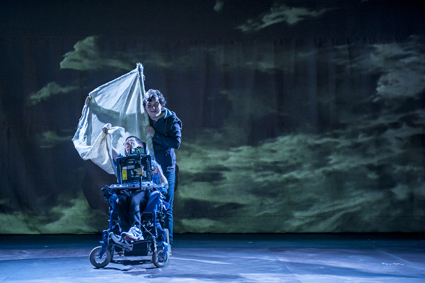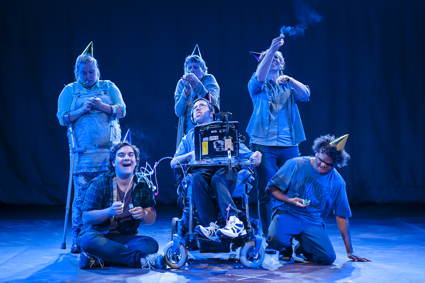Disability & its taboos
Ben Brooker: Tutti Arts, Eye Music

Anton Sagrillo, Brenton Shaw, Eye Music, Tutti
photo Sam Oster
Anton Sagrillo, Brenton Shaw, Eye Music, Tutti
“I died when I was nine months old.” The words, spoken by a synthesised voice, come out of the near darkness in which a lone man sits in an electric wheelchair.
The choppy, Americanised intonation is eerie in the gloom. On large screens behind the sentence slowly appears in Bliss symbols from the ideographic writing system. The man in the wheelchair is Jem (Anton Sagrillo) and his profoundly disabling cerebral palsy has already killed him once.
His second life, it would seem, could be worse. He has a best friend, the able-bodied Possum (Brenton John Shaw), a girlfriend, Wendy (Kathryn Hall), and two unstinting carers: grandmother Sylvia (Jacqy Phillips) and mother Jackie (Tamara Lee). But Jem wants to go to university, and his chances of living long enough to realise this dream are a fraction of what they are for the general population. It seems more than probable that, buried deeply beneath his defiant joie de vivre, Jem holds as pragmatic a view of his own impermanence as anyone.
In development for six years, Eye Music grew out of a series of conversations between playwright Pat Rix and Jem’s real life analogue, Jeremy Hartgen, which took place in the last year of Hartgen’s life. Under Edwin Kemp Attrill’s quietly ambitious direction, Hartgen’s biography is transfigured into a dynamic soap opera that freely interweaves the conventions of text-based and musical theatre. Wi-Fi technology is used to connect Sagrillo’s Bliss board (the performer too has cerebral palsy) with Nic Mollison’s dexterous AV design that integrates text, Bliss symbols, video and animation.
Along with composer and musical director Alies Sluiter’s songs—most of which are given to tenor Alistair Brasted to sing as Jem’s ‘inner voice’—all of this delivers a boldly successful account of the sound of the life of Jem’s mind. The name Eye Music hints at the difficulties inherent in bridging the communication gap between people of differing abilities, but the deployment of both aural and visual storytelling technologies, as well as enhanced disability access in the form of Auslan interpretation and audio description, effectively democratises Jem’s experience of physical impairment. The cruel dissonance between his restrictive, high maintenance biology and his unencumbered mind is most touchingly shown through a fantasy he shares with Possum about building a raft and sailing away, sans wheelchair.

Eye Music, Tutti
photo Sam Oster
Eye Music, Tutti
For all its enjoyable whimsy, Rix’s script does not fail to interrogate the profoundly contentious relationships between disability, faith, sex and assisted suicide. Jem is seen to independently navigate all of these, in the process delightfully upending the stubborn taboo that applies to sexual intercourse between disabled bodies. Within the context of the play, though, Jem’s loss of faith is the altogether more shocking transgression. The devout Sylvia rages like an uncomprehending child as Jem’s cognisance of his own mortality—and that of his friends as they are one after another consumed by physical and existential torment—turns him towards godlessness.
In the final scene, Jem’s own suffering has become too much for him to bear. A hydraulic winch lifts his lifeless body out of its earthly prison and into a vast, white armchair around which has been built the raft of his dreams. It is a transcendent, immaculately choreographed moment, reminiscent of the death of David Lynch’s John Merrick as he embraces the incorporeal as liberation. The sense of consolation that follows does not lie in the fact that we know him to be ‘going to a better place’ but rather that knowledge of its non-existence will no longer trouble him.
Tutti Arts, Eye Music, writer Pat Rix, director Edwin Kemp Attrill performers Anton Sagrillo, Jacqy Phillips, Tamara Lee, Roy Stewart, Brenton Shaw, Kathryn Hall, Alistair Brasted, Elliot Galvin, composer, musical director Alies Sluiter, lighting, projection Nic Mollison, designer Manda Webber, State Opera Studio, Adelaide, 22-31 May
RealTime issue #122 Aug-Sept 2014 pg. 44






